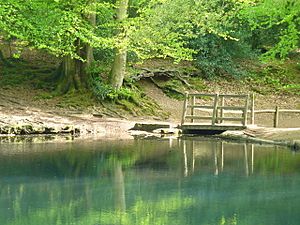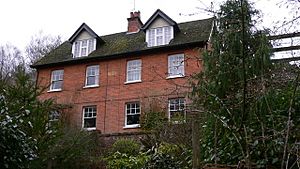Ludshott Common and Waggoners Wells facts for kids
Ludshott Common and Waggoners Wells are special places looked after by the National Trust. Ludshott Common is a big area of heathland, which is like open countryside with heather and gorse. Waggoners Wells has a few man-made ponds connected by a stream. You can find them in East Hampshire, England, between the villages of Grayshott, Bramshott, and Headley Down.
Contents
Ludshott Common
What is Ludshott Common?
Ludshott Common is one of the biggest heathlands left in East Hampshire. It stretches alongside the B3002 road, between Headley Down to the west and Grayshott to the east. It's about 700 acres (285 hectares) big!
Because it's home to many rare animals and plants, it's been given special protection. It's known as a Site of Special Scientific Interest (SSSI) and a Special Protection Area (SPA). This means it's really important for nature.
You might spot special birds like the woodlark, nightjar, and Dartford warbler here. There are also many kinds of spiders and butterflies, including the silver-studded blue, grayling, and green hairstreak. Look out for adders, grass snakes, and sand lizards too. Rabbits are common, and you might even see a roe deer. The most common trees are Scots pine and silver birch, with some oak trees.
Most of the common is covered in heather and gorse bushes on sandy soil. But there's a special spot with tall, old Scots pine trees that locals call "the cathedral" or "cathedral pines." It feels like a peaceful, open space under the trees.
In 2013, there were talks about bringing back grazing animals, like cows or sheep, to help manage about 550 acres of the common.
History of Ludshott Common
Ludshott Common has a very long history, going back to Saxon times. It was once part of the ancient Manor of Ludshott. In the Domesday Book of 1086, it was recorded as being under the control of Hugh de Port. Before that, in 1066, King Edward the Confessor was its overlord. Records of the local court, called court baron rolls, go back to around 1400.
The common looks the way it does today because local people used it for many centuries. They would let their cattle, pigs, sheep, and ponies graze there. They also collected gorse, heather, wood, and bracken. These materials were used for fuel, animal bedding, and winter food for their animals. This traditional use stopped around the early 1900s.
The National Trust bought the land in 1908. They wanted to protect it from new houses being built in Headley Down.
During the Second World War in the 1940s, Ludshott Common was used as a training ground for tanks. The heather was largely turned into mud. Luckily, the heather grew back, and people started managing the land from the 1970s onwards.
A camp for Canadian troops, called Superior Camp, was built at the eastern edge of the common. Even though it was taken down in the 1950s or 1960s, you can still see signs of where the buildings used to be.
On May 12, 1980, a large fire burned about 600 acres of the common. Strong winds made the fire spread quickly. People living in nearby streets had to leave their homes for safety. Firefighters worked for over seven hours to get the fire under control. Crews stayed overnight and into the next morning to make sure all small fires were out.
Waggoners Wells
Waggoners Wells is a beautiful spot with ponds surrounded by woodland. It sits in a steep valley between Ludshott Common to the north-west and Bramshott Common to the south-east.
The ponds were originally called Wakeners' Wells. They were created in the 1600s by the Hooke family, who lived in Bramshott. They might have been planned as "hammer ponds" to power local ironworks, but it seems they were never used for that. The woods around the ponds are famous for their tall, old beech trees.
You can drive to Waggoners Wells Lane from Grayshott. The lane leads to a ford and a small car park. The lane used to go all the way to the main London to Portsmouth road (A3). Now, only a footpath goes through the woods.
Activities at Waggoners Wells
Many people enjoy fishing here. You can catch and release fish like carp, roach, tench, and perch. It's also a great place for nature walks and birdwatching.
The stream that flows out of the furthest pond to the south-west is called Cooper's Stream. The house at the bottom of the ponds is called Summerden. It's a private home for the National Trust warden who looks after the area.
Near the house, there's a wishing well. The writer Flora Thompson mentioned this well in her books about the area. The stream from Waggoners Wells flows west towards Standford and then around Headley. Eventually, it joins the River Wey. This stream used to power many mills, including Headley Mill, which worked with iron. Paper mills also used the water from Waggoners Wells.
A famous band, Fleetwood Mac, even used Waggoners Wells for their music! The gatefold photo for their 1973 album Penguin was taken right here.
Images for kids




